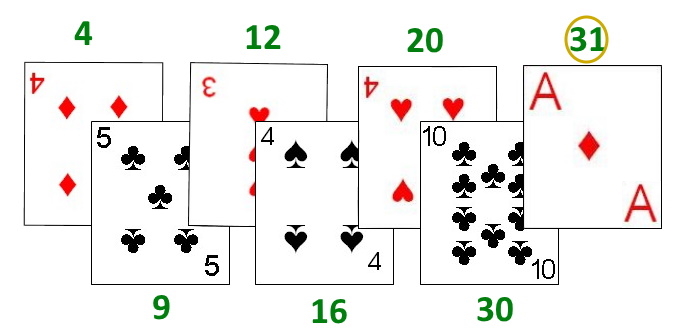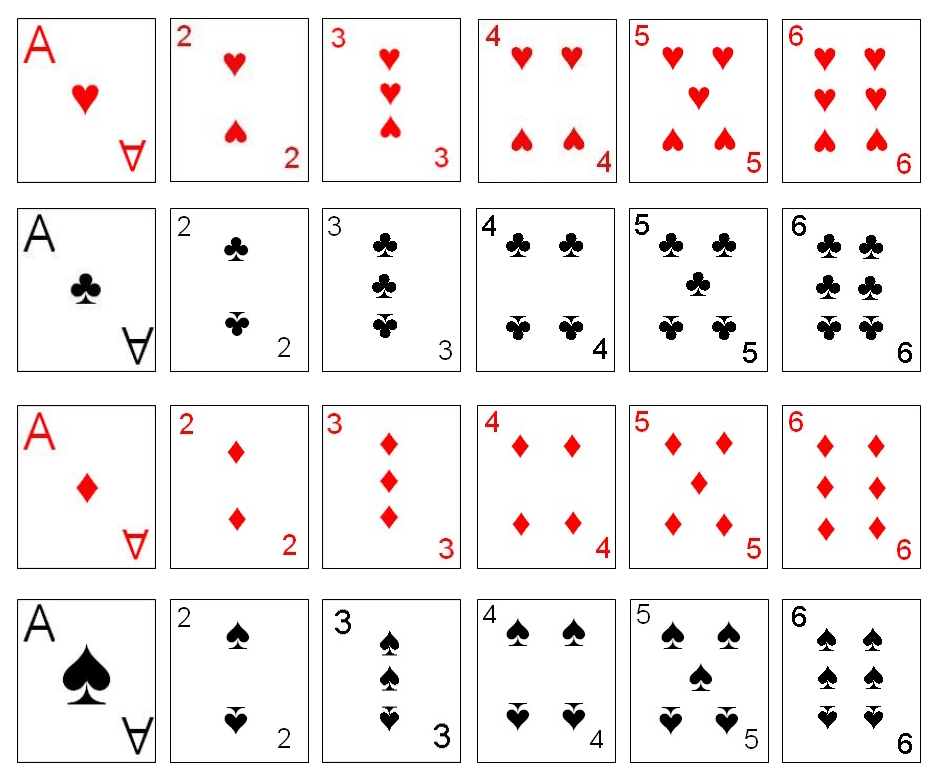The card game Wit and Reason is
one of perfect information, meaning that both participants in the game
have a complete knowledge of all variables at play and the exact cards
both he and his opponent possess at any time during the game. The rules for this game were first published in printed format
in 1674 in the first edition of Charles Cotton's famous publication,
The Compleat Gamester. The game was originally played in England.
Wit and Reason is designed for play by two and uses one standard deck of 52 cards, however there is no shuffle, cut or deal. Before play the cards are divided and one player is provided all the black suited cards (cards in the suits of
spades or clubs) and the other player is provided all the red suited cards (cards in the suits or
hearts or diamonds). Since the player with the first play on each game can have a significant advantage, this role should alternate amongst the two players after every game. For the first hand, to determine the first player, each player should draw a card from the shuffled deck (before the cards are divided amongst the players), with the player drawing the higher card having the first play on the first hand. If both players draw cards of the same denomination, both players should discard those cards and draw again. The ranking of the cards, for the purposes of this draw, are, from high to low; King, Queen, Jack, 10, 9, 8, 7, 6, 5, 4, 3, 2.
The game consists of the players alternately playing one card from his stack face-up to the center, starting with the player selected to start the game. Each card played has a counting value, which when played, is added to the current running total of the cards previously played
as per the following chart:
 |
|
| Card | Counting Value |
|---|
| Ace | 1 |
| 2, 3, 4, 5, 6, 7, 8, 9, 10 | Value marked on card |
| Jack, Queen, King | 10 |
|
As each player plays his card, during his turn, he announces the current running total of the play pile. The object of the game is to play a card which causes the running total to reach exactly 31, which wins the game for that player. A player may never play a card which would cause this total to exceed 31. If he has no card which he can play to prevent this, he must declare "Pass" and miss his turn. In the very rare
and unusual case in which neither player has a card which can be played which would not cause the total to exceed 31, the game ends in a draw. Other than the stipulation that the card played cannot cause the total to exceed a counting total of 31, there is not restriction on what card a player can play from his hand.
As mentioned previously, since the leader can have a significant advantage, the
player designated to lead on each should alternate amongst the two participants after each hand
and a full game session should consist of each player having an equal number of opportunities to thus lead.
 The Thirty-One Game:
The Thirty-One Game: An alternate form of the Wit and Reason, with the name "The Thirty One Game" was described in a book first published in 1907, by Henry Ernest Dudeney, with the title
The Canterbury Puzzles. In this book, the game was described more in the form of a puzzle, with a player attempting to find a consistently winning strategy. Strategy aside, the game also can make for a great exercise for
solidifying addition and logical thinking skills in young students.
As described in that book, the game has the same goal but is played
somewhat differently. This variant is also played by two participants,
and uses a standard deck in which all cards of denomination seven and
higher are removed, leaving a 24 card deck (which also includes the Aces).
To begin, all the cards should be arranged in a grid, in which the cards are arranged in a face-up row from Ace to six, one such row for each suit. Either player, by mutual arrangement then has the first turn. The first player then selects any currently face-up card in the layout, announcing it's value and turning it face-down. The next player in turn, then turns over another such card from the layout, and announces the value of this card turned summed to the value of the first card already turned. The value of a card is that as marked on the card, with an Ace turned over adding a value of one to the ongoing and accumulating sum. This continues, alternating with each player, on his turn, flipping over any remaining face-up card in the layout and announcing the current accumulating total.
If a player manages to cause the total to reach exactly 31, that player is immediately declared the winner. Alternatively, if a player has no available moves which would allow him to keep the value at or below 31, his opponent is immediately declared the winner.
Once a winner is declared, the cards should all be turned back face-up, the ongoing count resets to zero, and a new game played. Because certain strategies can be found that will make it almost certain that
the player with the first turn will win, the role of the first player should alternate amongst the two players.
Copyright © 2015-2025
CatsAtCards.com. All rights reserved.

